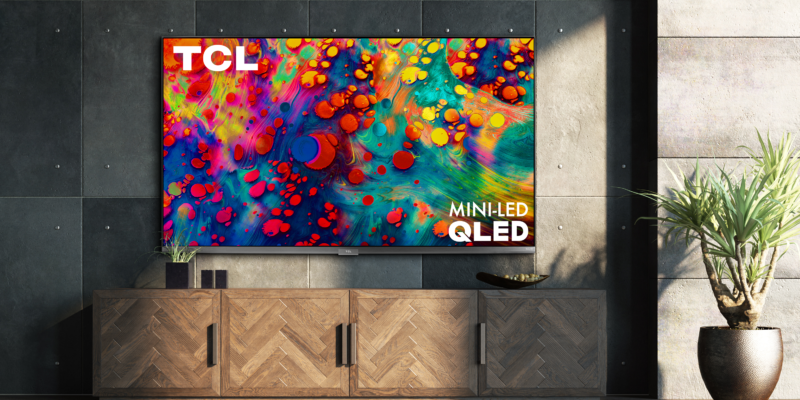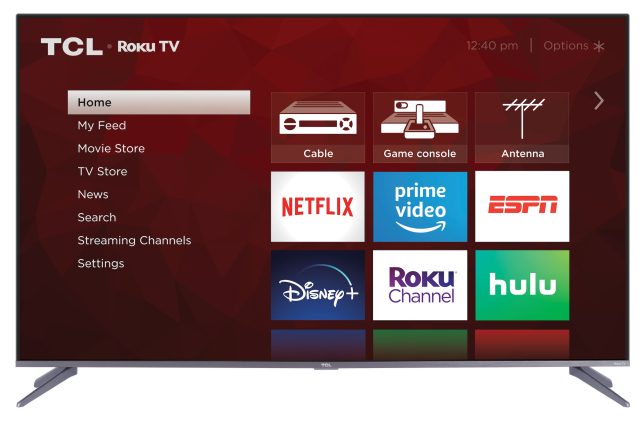
TCL on Tuesday launched the latest iterations of its popular 6-Series and 5-Series 4K HDR TVs. Both lineups are available starting today, though TCL says the former will have "limited availability" on Tuesday.
Prices for the 5-Series start at $400 for a 50-inch model, then move up to $450 for a 55-inch model, $630 for a 65-inch model, or $1,100 for a 75-inch model. The 6-Series, meanwhile, costs $650 for a 55-inch model, $900 for a 65-inch model, or $1,400 for a 75-inch model.
The 6-Series and 5-Series tend to be TCL's most recommended models for mainstream TV buyers, having offered laudable performance and simple Roku TV software at reasonable prices in recent years. The 6-Series slots in just below the company's highest-end 8-Series models, while the 5-Series sits just ahead of the more budget-friendly 4-Series and 3-Series TVs. In general, TCL's TV business has seen increasing success in the United States; today, the Chinese electronics firm only trails Samsung in US market share.6-Series 4K TVs: Moving up to mini-LEDs
The major addition to this year's 6-Series Roku TVs is mini-LED backlighting, which TCL first introduced to mass-market TVs with its premium 8-Series sets last year. As the name suggests, mini-LEDs are essentially smaller variants of traditional LEDs—generally 0.2mm or less. Because mini-LEDs are so mini, TV manufacturers can include much more of them in their displays: there are more than 25,000 mini-LEDs across the back of the aforementioned 8-Series, and TCL says there are "thousands" on the 6-Series.
The result, ideally, is a TV that can more precisely dim some parts of the screen while leaving other parts lit up, thereby improving contrast compared to a typical LED LCD panel. The dark parts of a picture can look darker, the bright parts can look brighter, and there should be less "blooming," wherein a bright part of an image seeps too far into what should be a dark part. (Think of an image where the night sky directly surrounding a bright Moon is unnaturally lighter than the rest of the darkness around it.)
In the case of the new 6-Series TVs, TCL says the mini-LEDs power up to 240 full-array local dimming zones—i.e., areas of the display that can be illuminated or dimmed by the backlight. That is significantly fewer than the 1,000 zones advertised on the 8-Series and less than some higher-end traditional LED TVs, so the contrast performance here probably won't be anything unheard of. That 240-zone figure only applies to the priciest 75-inch model, too.
Still, there's likely to be an improvement over last year's 6-Series TVs: whereas the prior 65-inch 6-Series model maxed out at 120 local dimming zones, for instance, this year's 65-inch set has 160. The 55-inch 6-Series TV, meanwhile, features 128 local dimming zones compared to 100 last year.
In general, mini-LED tech is something of a stopgap between aging LED-lit displays and more advanced display tech like OLED and microLED, both of which can achieve superior contrast by dimming each pixel individually. LG and, to a lesser extent, Sony have been the only TV makers capable of putting out OLED TVs at relatively attainable prices—though others like Vizio are starting to join them. MicroLED TVs may wind up being the gold standard for display quality—compared to mini-LEDs, microLEDs are around 0.01mm—but they still aren't available to general consumers in part due to high manufacturing costs. Mini-LEDs offer milder benefits, but benefits nonetheless—and they're more affordable to produce, hence why we're seeing the tech trickle down to popular TVs like the 6-Series today.Like last year's model, the new 6-Series utilizes a QLED display. For the unfamiliar, this is not the same as OLED, which is essentially a different—and largely superior—class of display. Instead, it's another iteration on traditional LED LCD panels—one that, when implemented well, can produce more saturated colors through the use of a light-filtering film of "quantum dots" between the backlight and the LCD layer. In simpler terms, there's reason to expect good color performance for the money, which was the case with last year's sets. High-quality LED panels can still outperform OLEDs when it comes to peak brightness, too, though TCL did not disclose how many nits of brightness the 6-Series can display.
Beyond that, TCL says the new 6-Series TVs support up to a 120Hz refresh rate and variable refresh rate (or VRR) tech that ranges from 48 to 120 frames per second. Both should help with motion smoothness, particularly with fast-paced video games. (The company has previously announced that VRR will arrive as an update to select 2019 6-Series TVs.) These are also the first TVs to carry THX's new Certified Game Mode label: this is a picture mode that aims to reduce latency and lag for competitive-minded games without sacrificing too much in the way of contrast and color. We'll have to see how well all of this works in action, but it could come in handy with the upcoming Xbox Series X and PlayStation 5. Each 6-Series TV will come with four HDMI ports, all of which support Auto Low Latency Mode (or ALLM)—which lets compatible game consoles switch to a TV's Game Mode on their own—and VRR. One port supports eARC, an audio-over-HDMI feature that helps simplify connectivity to soundbars and AV receivers. While these are notable features that come standard with the HDMI 2.1 spec, none of the 6-Series TVs has a dedicated HDMI 2.1 port, so you'll lose a modicum of future-proofing compared to higher-end TVs that cover the full spec.The 6-Series TVs themselves still have a brushed-metal finish with thin side borders, though they now include a clever cable-management system tucked within each model's stands. They still support Dolby Vision HDR, HDR10, HLG, and Dolby Atmos surround sound. And they all run Roku OS, which remains a straightforward platform for accessing streaming content, albeit one that is still missing new apps like HBO Max and Peacock due to publisher disputes.
5-Series 4K TVs: QLED and local dimming

The more affordable 5-Series Roku TVs should be a step down in picture quality, but they now come with QLED panels for the improved color benefits noted above. They also include a full-array local dimming feature for the first time: this only includes 40, 48, 56, or 80 zones depending on which size model you buy, which isn't a ton, but it should help the TVs perform better with HDR content. There are no mini-LEDs, though.
The 5-Series sets have four ALLM-supporting HDMI ports, with one port that supports eARC. They support Dolby Vision, HDR10, and HLG as well but max out at a 60Hz refresh rate. So, don't expect exceptional smoothness while gaming. The design here isn't quite as premium as that of the 6-Series, but its bezels are similarly slim, and it has the same built-in cable management system.
In more forward-looking news, TCL says it plans to provide more details on its new premium-tier 8-Series TVs, which will include at least one model with an 8K resolution, later this year.
reader comments
106